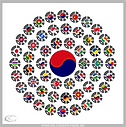About Lesson
Why did Koreans leave their Country and Disperse around the Globe? What is the Korean Diaspora?
 Students explore the Korean Diaspora and the factors that prompted Koreans to leave their country. They compare three waves of Korean immigrants and focus on immigrants to the United States. They interpret graphs and charts.
Students explore the Korean Diaspora and the factors that prompted Koreans to leave their country. They compare three waves of Korean immigrants and focus on immigrants to the United States. They interpret graphs and charts.
Activity Questions
- What are characteristics of a diaspora?
- What is the Korean Diaspora?
- Why did Koreans leave their country and disperse around the globe?
- Why did Koreans immigrate to the United States?
- How have reasons for Korean immigration to the United States evolved over time?
Instructional Strategies
- Use the Lesson 1: The Korean Diaspora and Korean Americans (Activity 1.1) presentation to support this lesson.
Defining Diaspora
- Have students share their ideas about the term, “diaspora,” and then present the first slide, What is a Diaspora? Lead students to the notion that Koreans are a diaspora.
Introduction to Korean Diaspora and Three Immigrant Waves
- Review slides on the three immigrant waves from Korea to the United States. Ask students to share stories of relatives and friends who were part of these immigrant waves.
Activity 1.1: Interpreting Graphs and Charts
- Individually or in pairs, have students complete the activity sheet, Korean Diaspora: Interpreting Graphs and Charts. When completed, have students compare their answers with another peer or pair.
Closing the Activity
- End class with review and discussion of the activity questions and/or the Research Extension (found under Lesson 1 Assessments and Extensions).
Resources
- Lesson 1 Teachers’ Guide and Lesson 1 Presentation are found on Lesson 1 Overview.
- Worksheet: Korean Diaspora Interpreting Graphs and Charts
- Additional resources are found under Lesson 1 Overview, Activity 1.1, Activity 1.2, Lesson 1 Videos, Lesson 1 Assessments, and Lesson 1 Research Extension

